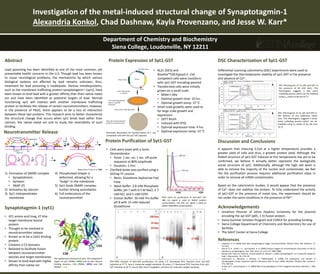
Konkol_ACS 2015
- 1. Department of Chemistry and Biochemistry Siena College, Loudonville, NY 12211 Investigation of the metal-induced structural change of Synaptotagmin-1 Alexandria Konkol, Chad Dashnaw, Kayla Provenzano, and Jesse W. Karr* Abstract Lead poisoning has been identified as one of the most common, yet preventable health concerns in the U.S. Though lead has been known to cause neurological problems, the mechanisms by which various biological systems are affected by lead remains unknown; thus, treatment for lead poisoning is inadequate. Various metalloproteins, such as the membrane trafficking protein synaptotagmin I (syt1), have been shown to bind lead with a greater affinity than their native metal ion and have been identified as potential targets of lead. Normal functioning syt1 will interact with another membrane trafficking protein to facilitate the release of certain neurotransmitters; however, in the presence of Pb(II), there appears to be a loss of interaction between these two proteins. This research aims to better characterize the structural change that occurs when syt1 binds lead rather than calcium, the native metal ion and to study the reversibility of such binding. Neurotransmitter Release adapted from Tucker et al. 2002 1) Formation of SNARE complex • Synaptobrevin • Syntaxin • SNAP-25 2) Activation by calcium 3) Syt1 interpenetrates membrane 4) Phospholipid bilayer is deformed, allowing for a “bulge” in the membrane 5) Syt1 binds SNARE complex, further driving assimilation 6) Full endocytosis of the neurotransmitter • 421 amino acid long, 47 kDa target membrane bound protein • Thought to be involved in neurotransmitter release • Known as to be a Ca(II) binding protein • Contains 2 C2 domains • Believed to facilitate fusion between neurotransmitter vesicles and target membranes • Shown to bind lead with higher affinity than native ion The quaternary structure of syt1. The cytoplasmic region of syt1 (PDBid: 2R83) and its two calcium binding domains, C2A (PDBid: 1BYN) and C2B (PDBid: 1TJX). C2A C2B Synaptotagmin-1 (syt1) Protein Expression of Syt1-GST Discussion and Conclusions It appears that inducing E.Coli at a higher temperature provides a greater yield of cells and thus, a greater protein yield. Although the folded structure of syt1-GST induced at this temperature has yet to be confirmed, we believe it actually better represent the biologically active structure of syt1. Additionally, although the high salt wash is able to remove the majority of the nucleic acid contaminate, we feel the the purification process requires additional purification steps in order to remove all mRNA contaminates. Based on the calorimetric studies, it would appear that the presence of Ca2+ does not stabilize the protein. To fully understand the activity of syt1-GST in the presence of metal ions, the experiment should be ran under the same conditions in the presence of Pb2+. Acknowledgements • Jonathon Pevsner of Johns Hopkins University for the plasmid encoding the syt-GST (p65, 1-5) fusion protein. • Siena Summer Scholars Program and CURCA for providing funding. • Siena College Department of Chemistry and Biochemistry for use of facilities. • The SAInT Center at Siena College References • Chapman, E. R. (2008) How does synaptotagmin trigger neurotransmitter release? Annu. Rev. Biochem. 77, 615-641. • Garcia, R. A., Forde, C. E., and Godwin, H. A. (2000) Calcium triggers an intramolecular association of the C2 domains in synaptotagmin. Proc. Nat. Acad. Sci. U.S.A. 97, 5883-5888. • Bouton CM, Frelin LP, Forde CE, Arnold Godwin H, Pevsner J. (2001) Synaptotagmin I is a molecular target for lead. J. Neurochem. 76, 1724-35. • Sukumaran, S., Banerjee, s., Bhasker, S., Thekkuveettil, A. (2008) The cytoplasmic C2A domain of synaptotagmin shows sequence specific interaction with its own mRNA. Biochem. Biophys. Res. Commun. 373, 509-514. • Tucker, W. C., and Chapman, E. R. (2002) Role of synaptotagmin in Ca2+-triggered exocytosis. Biochem. J. 366, 1–13. DSC Characterization of Syt1-GST Amp-R Gene Syt1-GST Gene Insert Plasmid into E. Coli Cell Cells containing plasmid express ampicillin resistance Grow cells on LBA agar plates Only cells receiving plasmid will form colonies on plate • BL21 (DE3) and RosettaTM(DE3)pLysS E. Coli competent cells were transform with syt1-GST encoding plasmid • Transformed cells were initially grown on a small scale: • Miller’s Mix • Optimal growth time: 10 hrs. • Optimal growth temp: 37 °C • Small scale growths were used to for large scale growth and expression: • 2XYT Broth • Induced with IPTG • Optimal expression time: 4 hrs. • Optimal expression temp: 37 °C SDS-PAGE Analysis of Syt1-GST purification. A) Lanes 1-5: Recovered FPLC fractions from syt1-GST induction at 37 °C; lane 6: molecular weight standards. B) Lanes 1-7: Recovered FPLC fractions from syt1- GST induction at 30 °C; lane 8: BSA; lane 9 myoglobin; and lane 10: molecular weight standards. Protein Purification of Syt1-GST • Cells were lysed with a Sonic Dismembrator • Pulse: 1 sec. on, 1 sec. off pulse sequence at 80% amplitude • Duration: 1 min • Clarified lysate was purified using a GSTrap FF column • Resin: Glutatione Sepharose Fast Flow • Wash Buffer: 2.8 mM Phosphate buffer, pH 7 with 0.5 M NaCl, 2.7 mM KCl, and 5 mM EDTA • Elution Buffer: 50 mM Tris buffer pH 8 with 15 mM reduced Glutathione FPLC trace for purification of syt1-GST. The 280 nm signal is used to detect protein concentration, the 254 nm signal is used to detect DNA/RNA contamination. Differential scanning calorimetry (DSC) experiments were used to investigate the thermodynamic stability of syt1-GST in the presence and absence of Ca2+. DSC thermogram of 15 µM syt1-GST in the presence of 90 mM CaCl2. This thermogram suggests a two event unfolding process which can be modeled using TM values of 48 and 52 °C. A B Schematic description for transformation of E. coli competent cells with the syt1-GST plasmid. DSC Thermogram of 15 µM syt1-GST in the absence of any additional metal ions. This thermogram suggests a three event unfolding process which can be modeled using TM values of 56, 66, and 70 °C.